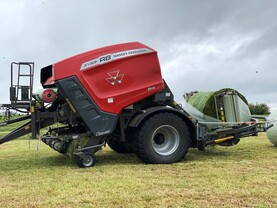Peter O’Reilly and his wife Geraldine have seen the benefits from changing to a plug-in hybrid electric car (PHEV). This is their first entry to the hybrid market and they are impressed with the results in terms of economy and annual running costs.
Peter runs a farm contracting and farming operation at Derrynure, outside Bailieborough, Co Cavan. He and Geraldine weighed up the costs of the petrol hybrid drive option against diesel power when buying the Outlander PHEV from their local dealer Albert Berry Motors Ltd, based at Ballybay Road, Monaghan town.
The Outlander PHEV is the family car for the O’Reillys. Peter uses a commercial 4x4 for his contracting and farming operations.
Most of the family driving is done by Geraldine and that’s mainly local commutes to and from schools and to the shops or other events in nearby Bailieborough.
For them, the Outlander PHEV gives very low cost local motoring. The electric drive range is 50km and that’s more than adequate for most daily runs. They estimate that this costs about €1.70 for an overnight charge. Add to this the lowest rate of annual road tax and the Mitsubishi Outlander gives the O’Reillys a very cost-effective form of transport.
The PHEV charging process is done using a standard 13amp fused socket through a special control box that assures safety during an overnight charge. Peter estimates that the car will have a full charge in about four to five hours to provide a maximum driving range of 50km.
During the summer months, when the car’s electrical system does not require the use of heaters, wipers, electric rear window de-mister, etc, there is less draw on the Outlander’s battery system. This is when the car is at its most efficient and they rarely have to top up the modest 45-litre petrol tank, as it’s almost never used.
“We have got into the habit of charging the car last thing each night almost in the same way that you charge other devices such as your mobile phone,” says Peter O’Reilly.
“Once you get into the habit of doing it and know that the charging system is safe, then it just becomes an automatic part of the day,” he says. “In the beginning, we thought about how we get used to it but now it’s just another simple routine job that’s done each night before closing up the house,” he adds.
Economy
The O’Reillys normally drive the car in eco mode to give the best economy. In this way, there is some recharging of the car’s battery system when driving, especially when braking on the typical hilly Cavan roads. This gives an additional electric power reserve to the 50km capacity from the overnight charging.
“We also like the fact that the all-wheel-drive system makes the Outlander PHEV a very steady car on the road,” says Peter O’Reilly. “The gearbox is a vario system and it is very smooth in operation,” says Peter, making driving very comfortable and easy.
“The boot space is also very good; very useful for family days out, but we are always a bit concerned about the lack of a spare wheel, which has not place in the boot floor due to the need for additional space for the hefty battery pack,” he says.
His only concern is the cap or cover for the car’s charging point. He considers this a bit flimsy for charging on windy nights and you can hear the unit flapping sometimes, always a concern that it will fall off or get twisted, but so far so good.
Mitsubishi claims that the Outlander model is the world’s best-selling PHEV, and the latest models come with a bigger 2.4-litre petrol engine compared with the 2.0-litre engine in the O’Reillys’ older version.
They claim that the new models have been improved with a 15% increase in battery capacity, and more power from the rear-mounted electric motor drives.
Prices: Entry prices for this new version of the Mitsubishi Outlander PHEV start at €39,900, which is getting close to being competitive with many mid-range diesel powered SUV’s with similar specifications.






 This is a subscriber-only article
This is a subscriber-only article









SHARING OPTIONS: